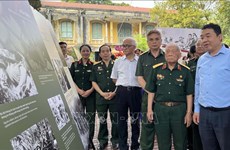Three simple steps to distinguish Vietnamese dynastic dragons
The most common in modern life are the dragons of the Vietnamese dynasties, from the Ly dynasty to the Nguyen dynasty. What are the distinctive features of each dynasty's dragon and what do they say about the history of that era?
VietnamPlus presents the three quick steps to identify the five most common dragon symbols in the aforementioned dynasties, with the assistance of Assoc Prof. Dr. Tran Trong Duong and young independent researcher Nguyen Hieu.
The video utilizes designs by Hieu and various other illustrative images. This is the result of reconstruction based on surveys, research from documents, stone sculptures, wood carvings, ancient architecture at historical sites such as pagodas, temples, royal tombs.
The Ly, Tran, Le So, Le Trung Hung, and Nguyen dynasties are notable in Vietnamese history for their distinct artistic styles. They can be differentiated into two types: the Ly-Tran dragon and the Le-Nguyen dragon, with the main distinction lying in the shape of the nose and head.
The Ly-Tran dragon features an elongated nose forming a trunk, often surrounded by flames to create a cluster called a crest. Dragons from the Le to Nguyen periods have snouts resembling animals, with rounded noses like lions.
Overall, the Tran dragon resembles that of the Ly period, with a thicker, more robust body due to the preference for tight compositions during the Ly period.
During the Tran period, artisans had more freedom in crafting dragons, resulting in a relaxed composition. Ly dragons were influenced by Buddhism, exhibiting elegance, while Tran dragons portrayed strength inspired by East Asian cultures.
From the early Le, Le Trung Hung to Nguyen periods, the fundamental features remained unchanged. To distinguish between them, a detailed analysis of features such as fins, and decorative clouds surrounding the dragon's figure is required.
In the early Le dynasty, dragon sculptures were basic, with features resembling lions, including thick lips and tufts of hair.
The early Le dragon was influenced by Confucianism and served as the foundation for the dragon depictions in later periods such as Le Trung Hung and Nguyen.
In the Le Trung Hung period, clouds and fur tufts became prominent, with clouds eventually resembling blades, covering parts of the dragon.
This is due to the turbulent times, with power being decentralized, leading to a strong folkloric portrayal of dragons. They were widely preserved and depicted in the architectural structures of temples and shrines in villages.
During the Nguyen dynasty, dragons regained their prominence as the main subject, while mythical beings like the "tail" and clouds became secondary elements. The horns of Nguyen dragons spread out rather than forming a dense cluster as before. Another characteristic is that Nguyen dragons have curly tail hairs.
Despite being standardized in size, they exhibited various folk variations due to the preservation of regional cultural nuances despite the scholarly cultural emphasis by the royal court.
In summary, from the Ly, Tran to the Le, Nguyen periods, Vietnamese dragons underwent continuous evolution, reflecting a harmonious blend of indigenous cultural elements (and regional influences), creating an iconic symbol that is both majestic and accessible./.













